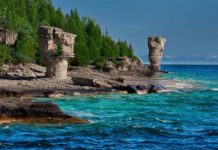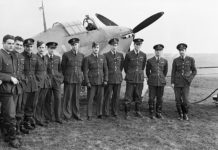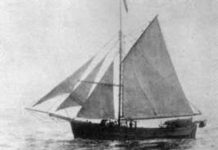The steam-whaler heavily loaded with supplies and equipment to last for many months, Captain Robert Bartlett and his crew sailed north from Victoria, BC. Leaving port in June 1913, HMCS Karluk was sailing initially to Nome, Alaska. Newly rigged with two masts as a brigantine, the Karluk was built in California as a salmon fishing vessel in 1884. It was purchased for $10,000 by anthropologist Vilhjalmur Stefansson for northern exploration. Refitting completed, the ship with 150-horsepower engine was ready for a three-year tour of duty in the Canadian Arctic Expedition.
Canadian Arctic Expedition Funded by Canadian Government
Led by Stefansson, the Canadian Government funded the Arctic exploration under arrangements made by Prime Minister Robert Borden. The group of 14 scientists plus explorers and ship’s crew were assigned to investigate Herschel Island in the Beaufort Sea for new territory and to survey the botany, mineral deposits and biology in the cold north.
Arriving at Nome, Alaska, two smaller schooners were purchased for the expedition – the Mary Sachs and the Alaska. Along with additional supplies, the extensive cargo on the Karluk was distributed among the three vessels. The crews set their compasses for the north, with HMCS Karluk as the flagship. But, said the Canadian Museum of Civilization (CMC), “it wasn’t long before things started to go wrong. The ice conditions off the north coast of Alaska were severe in 1913.”
HMCS Karluk Trapped in Pack Ice
By the first day of August, the Karluk was firmly trapped in heavy ice near Cape Halkatt, Alaska. “Carried first to the east by ice and winds,” noted the Canadian Museum of Civilization, “Karluk was then swept westward to the vicinity of Wrangel Island off the Siberian coast.” The two schooners Mary Sachs and Alaska were able to manoeuvre shallower waters to safety, making their way to Alaska’s Collinson Point for the winter. Drifting in the ice for five long months, HMCS Karluk’s structure weakened. Bursting through the side in January 1914, the rock-hard pack ice crushed the hull of the ship. The Karluk sank into the bone-chilling water.
There were no people aboard the ship when it finally sank. Captain Bartlett “anticipated the sinking weeks earlier when he ordered crewmembers to build igloos on the ice,” stated Jenny Higgins in “Bob Bartlett” of Newfoundland and Labrador Heritage. The men also transferred most of the supplies off the ship and ensured the safety of the vessel’s dogs and one cat.
Camps on Wrangel and Herschel Islands
The 25-member team set up camp and Captain Bartlett prepared to wait out the winter until daylight was longer, but four members did not want to linger. They “decided to immediately journey south on their own; none were heard from ever again,” noted Higgins. The remaining group managed to get to Wrangel and Herald Islands in mid-March, but four men died in unfortunate circumstances. It was suggested their stove emitted poisonous fumes, when their bodies were discovered eleven years later.
The Icy Arctic Ordeal was Over
With one man accompanying him, Captain Bartlett travelled 700 miles by dog sled to the Bering Strait and Alaska, and made the call for rescue to Ottawa on May 28th. Three more men died awaiting help. Two died from “nephritis, likely due to a starvation diet based on faulty pemmican,” according to CMC, and another “died of a gunshot wound” in a murky situation. The fishing schooner King and Winge chugged north, rescuing the stranded expedition survivors on September 7, 1914. Their dreadful eight-month ordeal was over.
Experienced Seafarer Bartlett, Arctic Anthropologist Stefansson
Well-seasoned in Arctic waters, Captain Robert Bartlett spent his life leading expeditions to the far north. Born in 1875 in Newfoundland to a family of seafarers, Barlett’s parents wanted a different future for their son, sending him to Methodist College to learn to be a preacher. However, sailing was in his blood and he left school for the seas. After a long career of seafaring excitement and adventures, Captain Bartlett died in 1948 of pneumonia.
Vilhjalmur Stefansson was born in northern Manitoba in 1879 to an immigrant Icelandic family. Raised in Winnipeg, he attended universities in the United States, studying anthropology and comparative religion. The young man made anthropology his career, participating in three expeditions to the Arctic. He shared his knowledge and experiences through several hundred articles and nearly two dozen books. Stefansson died in 1962.
Sources:
- “Canada’s Little Arctic Navy: The Ships of the Expedition,” Canadian Museum of Civilization
- Higgins, Jenny, “Bob Bartlett,” Newfoundland and Labrador Heritage 2008
- Palsson, Gisli, “The Legacy of Vilhjalmur Stefansson,” Stefansson Arctic Institute







